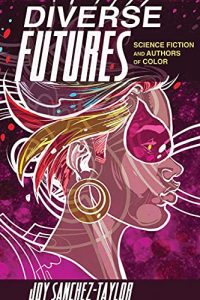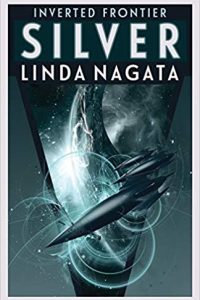Alvaro Zinos-Amaro Reviews Diverse Futures: Science Fiction and Authors of Color by Joy Sanchez-Taylor
 Diverse Futures: Science Fiction and Authors of Color, Joy Sanchez-Taylor (Ohio State University Press 978-0814257975, $29.95, 188pp, pb) August 2021.
Diverse Futures: Science Fiction and Authors of Color, Joy Sanchez-Taylor (Ohio State University Press 978-0814257975, $29.95, 188pp, pb) August 2021.
In her Introduction to Diverse Futures, Joy Sanchez-Taylor writes that this “project hopes to draw attention to science fiction authors of color who are often overlooked by critics and publishers when categorized into strict ethnic literary subgenres rather than being included in the broader genre of science fiction.” Throughout four chapters, arranged thematically rather than chronologically so as to illustrate commonalities as well as disparities in approach to selected themes and tropes, Sanchez-Taylor examines in detail well-known works, such as Octavia E. Butler’s Dawn and Fledgling, Ted Chiang’s “Story of Your Life”, Tananarive Due’s African Immortals series, Nalo Hopkinson’s Brown Girl in the Ring, and Colson Whitehead’s Zone One, alongside a host of narratives that, to the best of my knowledge, have received less critical attention. These include Celu Amberstone’s “Refugees”, Rosaura Sánchez & Beatrice Pita’s Lunar Braceros 2125–2148, and Gina Ruiz’s “Chanclas and Aliens” in Chapter 1, which explores how the tropes of space travel and first contact can “disrupt narratives of colonization”; Larissa Lai’s Salt Fish Girl in Chapter 2, focused on how fictional genetic engineering, mutation, and manipulation can “critique the history of scientifically justified violence against peoples of color”; Sabrina Vourvoulias’s Ink, Gabby Rivera’s “O.1”, and Ling Ma’s Severance in Chapter 3, centered on post-apocalyptic narratives and “race blind” futures; and Carlos Hernandez’s “The Assimilated Cuban’s Guide to Quantum Santeria” and Rivers Solomon’s An Unkindness of Ghosts in Chapter 4, which explores narrative integration of elements from “Eurowestern and Indigenous sciences and technologies.” I appreciate the inclusion of short stories alongside novels in these discussions, and it’s also exciting to see relatively recent books of genre import, such as Nnedi Okorafor’s The Book of Phoenix (2015) and N. K. Jemisin’s Broken Earth trilogy (2015–2017), be afforded ample space for critical discourse.
Addressing the volume’s subtitle, Sanchez-Taylor observes that “Displacement, diaspora, and marginalization are experiences that are not limited to one race or ethnicity, which is why bringing science fiction authors of color into conversation with one another serves to highlight the diversity of texts working to shift the focus of science fiction away from a Eurocentric perspective.” While she acknowledges that of the “the various movements fighting for a more diverse representation and interpretation within science fiction” each “deserves recognition in its own right, and… has attributes unique to specific races, ethnicities, and cultures,” there is also “a need for science fiction authors and critics of color to recognize the similarities of their science-fictional experiences, specifically those of colonization, diaspora, alienation, xenophobia, and gas-lighting….” The potential that Sanchez-Taylor identifies “for science fiction authors of color to learn from races and cultures outside their experience” speaks to the core possibilities of a genre putatively wedded to the infinite.
On the theoretical front, Sanchez-Taylor argues that “authors in this collection create a ‘double estrangement’ for science fiction readers,” by which she refers to a juxtaposition of Darko Suvin’s “cognitive estrangement” with W.E.B. DuBois’s notion of “double consciousness;” i.e. “the knowledge that peoples of color are always forced to view themselves through a lens of whiteness.” This strikes me as a potentially powerful signifier, and I wish I had seen more of its explicit application in the story analyses. Along related lines, Sanchez-Taylor cites Toni Morrison’s argument “that African slaves were the first peoples to experience the existential crisis of alienation that critics like Nietzsche define as inherent to modern civilization,” which couples powerfully with the idea in Chapter 1 that because “science fiction has a history of reinforcing Eurowestern colonial thinking, which often leaves authors and readers of color feeling alienated from the genre […] science fiction authors of color are often best suited to provide outside perspectives that challenge current representations of race in this genre.”
In her Conclusion, Sanchez-Taylor provides a handy list of publications and online communities that highlight science fiction by authors of color. Venues include Axxón, Genesis SF, Mithila Review, and La Bloga’s Latino Speculative Literature Directory, while the Facebook groups singled out for mention are The State of Black Science Fiction (18.7K members), Black Science Fiction Society (2 pages, each with 10K to 12K members), Afrofuturism (6.6K members), Imagining Indigenous Futurisms (3.2K members), and Asian Science Fiction and Fantasy (840 members). Sanchez-Taylor further identifies Sabrina Vourvoulias, Nalo Hopkinson, and Rebecca Roanhorse as creators who have helpfully authored “reading guides for fans who want more diverse science fiction reading options.” Discussing anthologies, she notes that “there are now many more anthologies celebrating science fiction and authors of color than when I began researching this project, but the number is still small compared to the overall number of anthologies celebrating white science fiction authors.” The enumerated titles, which include both fiction and non-fiction, are: Dark Matter: A Century of Speculative Fiction from the African Diaspora (2000), Dark Matter: Reading the Bones (2005), So Long Been Dreaming: Postcolonial Science Fiction and Fantasy (2004), Walking the Clouds: An Anthology of Indigenous Science Fiction (2012), Afrofuturism 2.0: The Rise of Astro-Blackness (2015), Stories for Chip: A Tribute to Samuel R. Delany (2015), Octavia’s Brood: Science Fiction Stories from Social Justice Movements (2015), Black and Brown Planets: The Politics of Race in Science Fiction (2014), Dis-Orienting Planets: Racial Representations of Asia in Science Fiction (2017), and New Suns: Original Speculative Fiction by People of Color (2019). The editors of these anthologies are Sheree R. Thomas, Nalo Hopkinson, Uppinder Mehan, Grace L. Dillon, Reynaldo Anderson, Charles E. Jones, Bill Campbell, adrienne maree brown, Walidah Imarisha, and Isiah Lavender III. Many have been involved with numerous other projects equally worth seeking out.
In addition to the aforementioned writers and editors, Diverse Futures contains many references to criticism on all of its covered topics, and so doubles as a primer for anyone curious as to the current state of academic thinking on these issues. These references inform the chapter-specific introductions and summations, and comprise a lengthy closing bibliography. Sanchez-Taylor leans particularly heavily on work by Grace L. Dillon throughout the book; Isiah Lavender III’s contributions are also alluded to with some frequency. Readers intrigued by Chapter 3, and more specifically by the notion that “cultures whohave already experienced the hardships of colonization, forced migration, and slavery” are in a sense already familiar with localized post-apocalypses may find Brent Ryan Bellamy’s recent Remainders of the American Century: Post-Apocalyptic Novels in the Age of U.S. Decline (2021) of additional interest. On the whole, Sanchez-Taylor tends to explain whatever academic terms or ideas she introduces, so that a layperson will, with some patience, be able to follow along. The implicit presumption of familiarity, therefore, in Chapter 4, with technical terms like “symbiogenesis” and “quantum entanglement,” which receive no explication, is, for this reader, puzzling, and makes an already difficult chapter unnecessarily more challenging. Despite the occasional jargon, though, Sanchez-Taylor makes her points with force, and underlines them through repetition. She concludes Chapter 3, for example, by wondering “whether humans are ready to decolonize not only their systems of government, but also their minds and hearts,” and ends Chapter 4 with the reflection “I argue that the first step in this process [finding balance in order to survive] is to decolonize our thinking about science and technology, a goal that science fiction authors can help achieve.” Her entreaties – and the areas of opportunity she identifies, both in our support of the creation of works by authors of color, and in the works’ subsequent reception – are clear.
If this book sees future editions, perhaps a few editorial emendations can be undertaken; Sofia Samatar is listed as Sofia Samitar in both the text and index; Gabby Rivera’s story “O.1”, which appeared in A People’s Future of the United States (2019), edited by John Joseph Adams & Victor LaValle, is alternately given as “0.1” and, more often (see the extended treatment in Chapter 3) as “1.0”; Gina Ruiz is sometimes spelled Gina Ruíz; Ted Chiang’s “Story of Your Life” is listed as published in 2010, but first appeared in the 1998 anthology Starlight 2, edited by Patrick Nielsen Hayden; I have not performed an exhaustive verification of names, dates, or checked all the annotations.
In the opening pages of Diverse Futures Sanchez-Taylor expresses the hope that “this project is the start of a larger conversation about how the science fiction genre can work to be more inclusive of authors of color and the non-Eurocentric futures these authors imagine.” To paraphrase Toni Morrison, we are all the things we have ever loved.
This review and more like it in the November 2021 issue of Locus.
 While you are here, please take a moment to support Locus with a one-time or recurring donation. We rely on reader donations to keep the magazine and site going, and would like to keep the site paywall free, but WE NEED YOUR FINANCIAL SUPPORT to continue quality coverage of the science fiction and fantasy field.
While you are here, please take a moment to support Locus with a one-time or recurring donation. We rely on reader donations to keep the magazine and site going, and would like to keep the site paywall free, but WE NEED YOUR FINANCIAL SUPPORT to continue quality coverage of the science fiction and fantasy field.
©Locus Magazine. Copyrighted material may not be republished without permission of LSFF.







